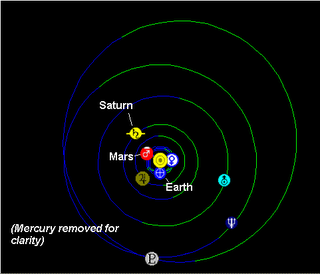In total, three planets should be visible in the western sky just after sundown; from the horizon up, Mercury, Mars and Saturn. Let's start with the least visible of the bunch, Mercury.
As you probably well know, doing astronomy just after the Sun has disappeared below the horizon is tough, especially if you intend to look in that general direction. At 8:30pm EDT, Mercury will be just about 10° above the horizon and visible in the twilight glow. As far as planets go, little Mercury is the runt of the inner Solar System, the first of the so-called "Terrestrial Planets" (as opposed to the outer Solar System, which is dominated by the "Gas Giants"). It isn't big at all, a little over 3000 miles (4880 km) in diameter, about 1 1/2 times the size of our own Moon. Because of that, don't expect much even with a big telescope; Mercury is a small planet to begin with, and we're seeing it from over 100 million miles (160 million kilometers) away. The problem locally will be one of haze. We're entering into the hot months now, and northeast Florida does get notoriously hazy this time of year. However, we're also expecting storms on Friday, and they can help to clear a lot of that up. Either way, little starlike Mercury is only the beginning of the happenings on the 16th. A better show is just a little higher up.
From time to time, the planets appear to close in on one another in our skies. Of course, they are actually very, very far apart, but this does make for some great observing possibilities. That's what we'll have in Saturn and Mars.
They're going to look close. Real close. The apparent angle of separation (that's geek-speak for how far they appear apart) will be around 1°, or almost two full Moons. Due to the enormous differences in their sizes, though, they will look very different from one another. Mars is a little more than half the size of Earth, 4221 miles (6794 km) and glows with an orange-tan glow. Saturn, on the other hand, is over 17 times as big, almost 75000 miles (120700 km) in diameter. Even though Saturn will almost be a billion miles out (1.6 billion km), it will still outshine Mars!
The Vagabond Astronomer will be setting up at County Dock in Mandarin around 8:00 pm. This gives us the best view west. Because of how crowded the conditions are out there, only one scope will be used, and no, I will not be setting up on the dock itself but next to it. Besides, brackish water and fine optics do not a good couple make.
Hope to see you there.
As you probably well know, doing astronomy just after the Sun has disappeared below the horizon is tough, especially if you intend to look in that general direction. At 8:30pm EDT, Mercury will be just about 10° above the horizon and visible in the twilight glow. As far as planets go, little Mercury is the runt of the inner Solar System, the first of the so-called "Terrestrial Planets" (as opposed to the outer Solar System, which is dominated by the "Gas Giants"). It isn't big at all, a little over 3000 miles (4880 km) in diameter, about 1 1/2 times the size of our own Moon. Because of that, don't expect much even with a big telescope; Mercury is a small planet to begin with, and we're seeing it from over 100 million miles (160 million kilometers) away. The problem locally will be one of haze. We're entering into the hot months now, and northeast Florida does get notoriously hazy this time of year. However, we're also expecting storms on Friday, and they can help to clear a lot of that up. Either way, little starlike Mercury is only the beginning of the happenings on the 16th. A better show is just a little higher up.
From time to time, the planets appear to close in on one another in our skies. Of course, they are actually very, very far apart, but this does make for some great observing possibilities. That's what we'll have in Saturn and Mars.
They're going to look close. Real close. The apparent angle of separation (that's geek-speak for how far they appear apart) will be around 1°, or almost two full Moons. Due to the enormous differences in their sizes, though, they will look very different from one another. Mars is a little more than half the size of Earth, 4221 miles (6794 km) and glows with an orange-tan glow. Saturn, on the other hand, is over 17 times as big, almost 75000 miles (120700 km) in diameter. Even though Saturn will almost be a billion miles out (1.6 billion km), it will still outshine Mars!
The Vagabond Astronomer will be setting up at County Dock in Mandarin around 8:00 pm. This gives us the best view west. Because of how crowded the conditions are out there, only one scope will be used, and no, I will not be setting up on the dock itself but next to it. Besides, brackish water and fine optics do not a good couple make.
Hope to see you there.


1 comment:
Just wanted to post a follow up to tonight. To be honest... they really didn't become visible until 9:00pm, and then by 9:45 were lost in the haze. Add to that the fact that "Dyna", my 6"/152mm SCT was out of alignment... you get the picture. Still, was fun and met some great people tonight... thanks Webbie and Mike for hanging out!
The Vagabond
Post a Comment